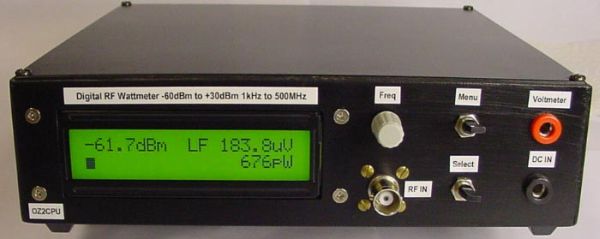Updated 3. Sep. 2002.
If you are from Denmark ! read the Danish version !!
In the good old days I had some parts but now
This Wattmeter is in ELEKTOR MAGAZINE OKTOBER 2002, they will sell PIC and PCB
The extra input B is for a later SWR brigde project, also the TX serial output will be in use later.
The uncalibrated signal response is: +1/-1 dB from 1MHz to 450MHz.
Input SWR vill varry from 1.00 to 1.30, depending on input frequency.
To make the SWR this good, you need to assemble the input circuit correct and adjust the capasitor.

Input power range: -60 to +30dBm that is 1 nW to 1 Watt.
This instrument can be used and calibrated from 1 kHz and up to 500 MHz
It is possible to measure power relative all the way up to 900Mhz
A software routine can calibrate the 0dBm point at 5 different frequencies to make this instrument accurate within 0.5dBm !!
The calibration data is stored in EEPROM so the instrument will remember all, also without power.
At frequencies above 300Mhz this instrument should not exceed inputs over +20dBm (100mW) to keep the good accuacy
This is a documented weekness in the AD8307, this is not a big problem, if you are aware of this, then it’s just a matter of using the right input attenuator
If battery opperation: do not connect R30, also change R26 and R27 to 4k7
Ideas taken from articles in: QST June 2001 page 38 and Funkamateur 12/99 page 1383 And Elektor 1/99 page 26
The display, shows dBm from -60 to +30dBm, RF Voltage and RF Power and Bargraph in 1db step.
The backlite is verry powerfull, I had to change R30 to 10E
Also I must complement the POWERTIP display for it’s exelent contrast and viewing angle and low prize !
I use a POWERTIP display with 20 caracters in 2 lines with LED light.
Powersupply current is:
With no light: = 30 mA. (R30 = NC)
Normal light: = 120 mA. (R30 = 10E)
Power light: = 200 mA. (R30 = 4E7)
For more detail: Digital Watt meter using PIC16F876
